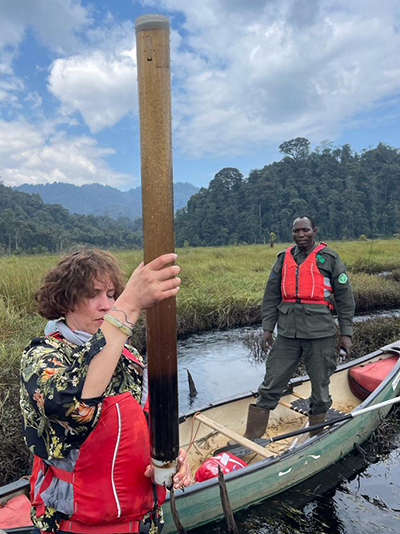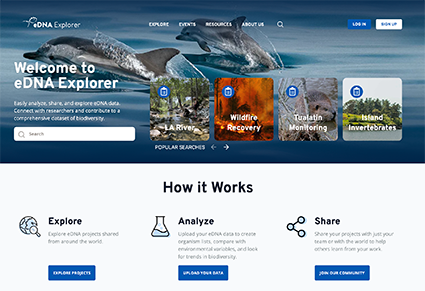CALeDNA, a UC-wide consortium project to document California’s biodiversity, has launched a prototype of their new eDNA Explorer. This open-source tool provides a powerful and easily accessible platform for sharing, exploring, and analyzing data from projects that use environmental DNA.
Environmental DNA, or eDNA, is a tool for monitoring biodiversity that involves analyzing DNA found in soil or water samples from a specific location to determine which species are present in that area. For the past several years, CALeDNA has been using this technique to sample regions across the state of California.
The CALeDNA program is directed by Rachel Meyer, assistant professor of ecology and evolutionary biology at UC Santa Cruz and an affiliate of the UC Santa Cruz Genomics Institute. CALeDNA has led collections of eDNA in Swanton Pacific Ranch after it was devastated by wildfires, the LA River, farms in the Central Valley, and a host of other locations.
Although CALeDNA started in California, it has grown to have a global reach. A recent project involved running research-based workshops on using eDNA to guide rewilding in Rwanda, in which managers of Akagera National Park collaborate with scientists from Rwandan and other African environmental organizations and universities to analyze the data together. Data from all of these sites and more than a dozen other projects throughout the U.S. and Africa are now visible to the public on eDNA Explorer.
Julie Stanford, who co-created the eDNA Explorer, is excited for the opportunity it will give the community to make a real impact on the global biodiversity crisis.
“This first version is just the beginning of a series of tools that we are launching to illuminate the hidden creatures in our ecosystems and provide insights on the biodiversity we are trying to protect,” Stanford said. “I can’t wait to collaborate with everyone on this platform.”
The web tool serves as a project management and collaboration platform that helps people figure out where rare species are and how communities change across space and time. One popular species is the elusive African barred owlet, which turned up in an eDNA sample with a match to the genus Glaucidium, the group for all pygmy owls.
“The African barred owlet had last been recorded in 1981,” said Drew Bantlin, Conservation and Research Manager at African Parks. “In 2021, we recorded multiple calls and then sighted multiple individuals that appeared to be resident in a single drainage line in the north-central part of the park. Finding DNA from the south side of the park suggests the species is more widespread than thought.”
The CALeDNA project has relied on heavy involvement from citizen scientists, and the eDNA Explorer tool is designed so that it can be used by beginners and experts alike. It creates a common format for data and converts raw project sequence data uploaded by researchers, park managers, and others into a reliable organism list in the cloud. It also facilitates comparing eDNA data with that from more traditional observational methods of biomonitoring.
eDNA only lasts for an average of two weeks before it is degraded, so it provides a good sense of the current inhabitants of a given area. In some regions, researchers have been able to extract older, more degraded DNA from preserved areas (for instance from under the concrete of the LA River), to find what species used to be in an area.
It is not a perfect science, however. Looking through the eDNA Explorer’s list of species that are present in the LA River, for example, one can find the presence of bovine DNA. This is not because there are actually cows roaming the river, but because bovine DNA gets into the river through human waste. This is an example of what scientists refer to as “noise” in the data. As tools like the eDNA Explorer make eDNA data more accessible, Meyer predicts that scientists will learn how to better sift through the results to quickly answer specific questions about conservation.
“As we explore eDNA regardless of the noise, there is a lot of promise,” Meyer said. “It works really well for answering a specific question, like ‘where in Compton Creek are there invasive clawed frogs?’ That’s a question anyone can answer now by downloading the data from our Explorer tool, and we can use that information to aid efforts to target interventions in specific areas.”
The tool also allows users to find information on specific organisms, projects in their area, and even the people who have worked on those projects and their methodology, like a “LinkedIn for eDNA,” as Meyer describes it. The tool is designed to remove the barriers to designing protocols and analyzing environmental data, with the ultimate goal of providing a better understanding of the living world.
“We recently had a State of the Los Angeles River Watershed Symposium, and we had government officials looking for pathogens to decide if it is safe for humans to fish in certain areas, conservation groups who are restoring natural habitats, and tribal leaders trying to envision what the LA river should be and how to make it a happier space for humans and wildlife,” Meyer said. “eDNA is helping us answer all of these questions, and this tool will help us to expand our collaborations to encompass even more areas of exploration.”
With the eDNA Explorer launched, Meyer said the next step is training more people how to use it. She and other CALeDNA researchers just returned from a second Rwanda workshop in Nyungwe National Park, and are currently in South African surveying rivers with eDNA that runs through agricultural land. The local farmers of the cape winelands will be invited to join eDNA Explorer to dive into the biodiversity of their local habitats. With unprecedented flooding in South Africa this year, eDNA can be a useful tool to find species that may help the rivers and adjacent lands stabilize and recover.


Scientists in Rwanda survey the biodiversity of local rivers with eDNA.
“I am really excited about what this tool will allow researchers, and even just interested citizens, to understand about the land we all call home,” Meyer said. “We are just at the beginning of seeing what it can make possible. It gives me a lot of hope.”
“Seeing how Professor Meyer and her team have brought the power and potential of genomics, high-throughput data generation, and analysis to conservation is incredibly exciting,” said Lauren Linton Executive Director, UCSC Genomics Institute. "At the Genomics Institute we are actively expanding our view and impact in many ways. It is fantastic to see Rachel blaze this important trail at a crucial time for conservation efforts.”
The researchers behind eDNA Explorer invite anyone to visit the tool, explore the data, and upload their own sequences. The project was made possible through the generous support of Oceankind, and the workshops in Rwanda were funded by grants from National Geographic and the JRS Foundation to lead investigator Ren Larison at UCLA.




